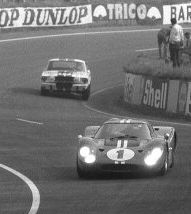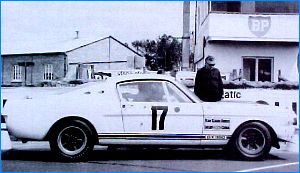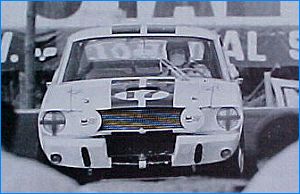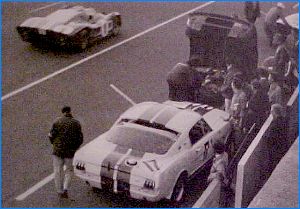|
Sorry, it took quite a while to get this up. This is part 1 of 3, as the full interview was about 8 pages long. |
Claude Dubois was a successful race pilot of the 60ies and 70ies and exclusive car dealer for Shelbys, Frua, De Tomaso, AC and a variety of others. As the initiator of the 1971/1972 Shelby Europa G.T.350 and G.T.500 models he gained additional interest in the performance car world. Having owned SFM5R539, one of the 1965 Competition Shelbys and driven at Le Mans in 1967 is another point that may cause more interest in this interview plus the fact that SFM5R539 was briefly shown at the Le Mans Classic in 2004 again after a complete restoration, but vanished since then from the race tracks again. The car is however still in Belgium with Patrick C. Read on. |
|
Bonjour, Claude, thanks for your willingness for this interview. The SAAC files tell us that you initially intended to enter your Ferrari GTB for Le Mans 1967, although you were a true Ford and Shelby dealer at that time. Can you tell us more about that and when did you meet Carroll Shelby for the first time? |
Well, I got in contact with Carrol for the first time in December 1965, when Ford Motor Company asked their subsidiaries in Europe (amongst them Ford Antwerp in Belgium) to find a suitable dealer in each country - to distribute the Ford High Performance and racing cars like GT40, G.T.350 and Cobras. The father of Jacky Ickx, a past personal friend influenced Ford Antwerp to appoint Jacques Swaters of the Ecurie Francorchamps (and a Ferrari distributor) as a Shelby distributor. What a silly idea..., but finally Ford decided to appoint me, advised by a Ford employee that I knew personally. His name was J.C.Martha. So, I began - on the Ford stand - to sell these cars on an exclusive basis for Belgium and as a special Ford dealer. The event was the 1966 Bruxelles Motor Show, where a racing Cobra 427, a Shelby G.T.350 and a GT 40 were displayed. I sold 9 Shelby at the show, but the Ford Motor Cy system was too big and
complicated to effectively handle such special orders and when I met for the
first time Carroll at Le Mans in April at the practice week end, I discovered
that my sold cars had not even been ordered by Ford Antwerp to Shelby in Los
Angeles. It is then that Carroll told me "let forget those.... at Ford and
work directly with me as sole importer for Belgium, Holland and Luxembourg
(Benelux countries) starting January 1st, 1967, which we did. |
|
Was SFM5R539 directly delivered to you for the Le Mans race in June 1967? |
Yes, in April 1967, but to be accurate, it had been ordered by and shipped to Ford Antwerp. I was still a dealer of Ford Antwerp and had good relations to them, but purchased parts only, the cars being - as expained before, a direct and smoothly working deal, between Carroll and myself.. In case of SFM5R539 however Ford Antwerp was the owner and I was just driving it, but also responsible for its maintenance and preparation. |
|
What was modified for Le Mans 1967?  SFM5R539 with Claude Dubois at the steering wheel chasing the rest of the herd at Le Mans 1967 Photo courtesy Ford Media  SFM5R539 at Le Mans 1967 - 267kmh at 7.000 rpms max speed with home made front spoiler and rear fender extensions Picture courtesy Jacques Guerin/MCde France  Note the special wiper set up, the Marchal lights. Security is cleaning the debris of another car in the forefront Picture courtesy Jacque Guerin/MC de France |
After the April 1967 Le mans testings, I discovered that the car was completely worn out, because of its past 1965 and 1966 racing seasons in the USA. I think Shelby did not believe this deal of selling a car for Le Mans to Ford Antwerp was anything else than a Belgian joke. The car had not even been checked before shipment to Europe. But in April, at Le Mans, Carroll discovered that not only I had well obtained an entry at Le Mans in the GT class, but also that we putted decent lap times. I also spoke to him and explained that this would be my 8th Le Mans participation. So he took the matters more seriously and was also probably advised to do so by two extremely nice gentlemen that I met in the Ford pits and that are still good friends of mine. One is called Don Coleman and he was the Ford executive in charge of the small V8 race engine program (the 289/302) and the other was Ray Geddes, a high level guy in the total Ford racing programms. Those two friends became later on top executives in the Pantera Ford/De Tomaso programm. To come back to the modifications I made to the car: |
|
Was Le Mans 1967 the first race in Europe for SFM5R539? |
Yes, Le Mans 67 was the first race. In April we got the car for testing and in June we entered the car at Le Mans. In between we made the modifications. |
|
Do you remember other team members aside from your co-driver Tuerlinckx? |
The team was outside my mechanics a bunch of friends willing to help for free. Pierre Schimp, his daughter and wife and his cousin Michel Grondel (today my computer expert) would handle the signalling pit then at the exit of the slow Mulsanne bend. Some friends would handle the pit and timing management, the catering was done by the wifes and girl friends - well, a true club racing atmosphere. My mechanic team was Jojo and his father Bruno Casier. Two extremely competent guys. Pierre Schimp was a cousin of Paul Frere. He used to signal all the cars of the Equipe Nationele Belge at Le Mans since many years in a very efficient way. So I asked him to do that. We had no radio in the car then, so the team manager would telephone Mulsanne to give the signalling pit the informations to inform pilots with handheld billboards. Drivers had enough time to give a quick look on the right reading those billboards, when exiting Mulsanne and leaving first gear at 7.000 rpms (at 80mph, to engage second gear. |
|
From which position did you start in Le Mans 1967? |
I don't remember exactly, I suppose I had some problems when starting or during the first laps, because we were in 52nd position at the end of the first hour, 46th at the second hour and 41st, when we abandoned. |
|
Do you remember any special incidents during the race? |
In the chaos of the Le Mans start another car probably hit me, because I had to stop after one or two lamps to check the front spoiler. One half of it was lost. So the handling in the Hunaudieres was funny - the nose of the car pointing to the sky..... naturally the G.T. 350 was not an example of good streamlining and not really designed for real high speeds. |
|
What was the exact cause for your DNF in Le Mans?  5R539 in the pits at Le Mans 1967 Picture courtesy David Friedman |
A crack in the Borg-Warner T10 transmission extension, resulting in a massive oil leak. I thought that this was a coincidence or perhaps a bad casting, but it happened again at the Spa 24 hours race for Touring cars, two months after Le Mans. When I explained this to Carroll Shelby, his reaction was "Oh yeah, we know that f.... problem, it happened all the time on the early Cobras 289 with the same transmission, always on fast tracks like Reims or Spa or Le Mans". I was quite unhappy with that answer and believe Shelby could have warned us about that weakness - before Le Mans, not after! In 1968, SFM5R539 finished the Spa 24 hours race in second place overall, without a single problem... but a Ford cast iron Toploader transmission that had been fitted instead of the BW T10. The ratios of the T10 were better suited to racing purposes, but on the Spa circuit, one uses almost only top gear, so this was not a problem. I learned recently that we had also make a pit stop for a problem with the steering at Le Mans, but I don't remember that. I was exhausted, mentally and physically, before the race, because I worked like hell to organize everything, prepare the car and still continue to manage my little dealership, too. When we arrived at Le Mans we discovered that for the first time in the race history, qualifications became compulsory. It was required to achieve at least 85% of the average speed achieved by the fastest car. In 1967 that meant that, with a Mustang with a top speed of 267km/h, we had to achieve 85% of A.J. Foyt Ford MKII 7 litre that had a top speed of 340km/h in the Hunaudieres, which is a 7km long straightaway. The problem was that the organizers had forgotten that two types of race car took part in the event - Prototypes and production cars derived Grand Turismo cars and hat set the same qualifying speed for everybody! This would be corrected in the following edition of Le Mans, but in 1967, well, we hand to do with that. This was in fact impossible. I did my best during many practice laps, but could not do better than - if I remember well - 4.15", which was 2 seconds too slow to qualify. Perhaps I was also not in a too good shape then, because of my physical condition. In the race I went down to 4.10" with the G.T. 350 - much quicker
than with my Ferrari 275GTB the year before, however. Anyway my co-driver
Chris Tuerlinckx, a very good pilot, managed to qualify the car at
4.13", using some slipstreaming techniques, when he was lucky enough
to follow a car that was a tad quicker in the Hunaudieres and get 5R539 to
go well over our limit of 7.000 rpms. The car could normally not exceed
this limit under its own power, when not aspirated, because we were
running of course a long final gear ratio. I believe, it was a
3.25:1. |
|
|
|
E-Mail
Back to Shelby Europa Main page